It was madness to think that a single blog post could convey the fantastic diversity of Umlauts in Berlin … so we’ve decided to celebrate the Umlaut over the course of three different posts, each devoted to a different umlauted letter. The first post was devoted to the Ü, and the second explored the diverse applications of the Ä. In the final instalment we look at the glory of the Ö.
There is no statistical or empirical evidence to support the claim that the Ö is the most common of the three umlauted letters in the German language … but this is the impression one gets from casual observation. Even more than the Ä or the Ü, the Ö seems woven so comprehensively into the fabric of the quotidian that it becomes simply a part of the texture. And the more common something is, the less we tend to notice it.
Certainly the Ö is everywhere. It is an integral part of everything that is schön and höhe in German, but it can also be found on the road to Hölle. In the non-German parts of the western world, the Ö has a celebrated association with hard rock thanks to its conspicuous presence in the identities of Blue Öyster Cult, Motörhead and Mötley Crüe. In Berlin, however, it is simply a part of daily life. For most residents of Schöneberg, Schöneweide and Schönholz – to say nothing of Köpenick, Hönow and Neukölln – the diacritic is as unremarkable as the buildings one must walk past each day on their way to the station. Few people waiting in the queue for a late night snack will give a second thought the Ö in Döner. No one goes to Görlitzer Park for the orthography.

The Ö welcomes visitors to S-Bahnhof Köpenick.

This umlaut also appeared on our Stations of the Ring post a few months back.
Yet for its ubiquity the Ö does not go uncelebrated; and the more time one spends wandering the streets of Berlin, the more one begins to notice both the diversity of approaches and the recurring trends. As with the Ä and the Ü, there are multiple options when it comes to the form and placement of the diaeresis: one can, of course, place two simple dots just above the top of the O, but it is also possible to separate the dots and push them out to the sides, or even to situate the diacritic within the letter itself.
The round shape of the O also makes an ideal sanctuary for a superscript E, although this configuration appears infrequently.
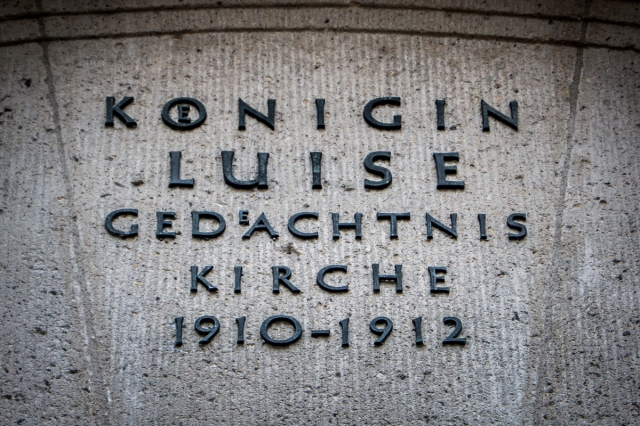
The E inside the O. The superscript E makes a subsequent appearance in Gedächtnis.
We have seen in other umlauted letters that lines are sometimes used instead of dots, but this approach seems to be especially common with the Ö. One often finds lines that extend through the upper arc of the letter and into the counter, resulting in a shape that looks not dissimilar to the international symbol for ‘power button’. Of course, sometimes things get out of hand and the lines are allowed to rise to ridiculous heights.

Two down-strokes of neon slice through the Ö in Zubehör.

The wedding-ring Umlaut of Sporthalle Schöneberg.

These two lines almost reach the centre of the letter.

The Ö taken to new heights.
The diagonal umlaut is also not uncommon. While the double acute diacritic is a feature of Hungarian, the heavily slanted umlauts of Berlin are purely stylistic.
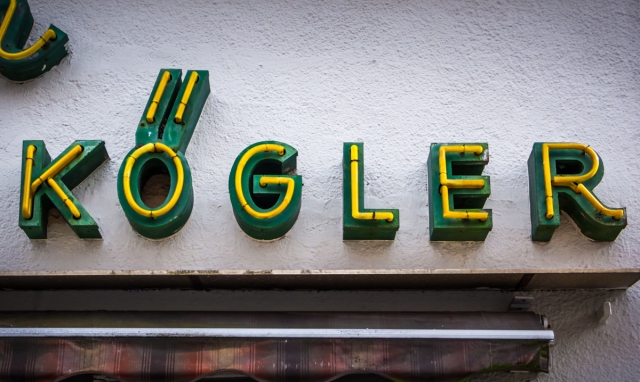
The twin diagonals suggest rabbit ears.
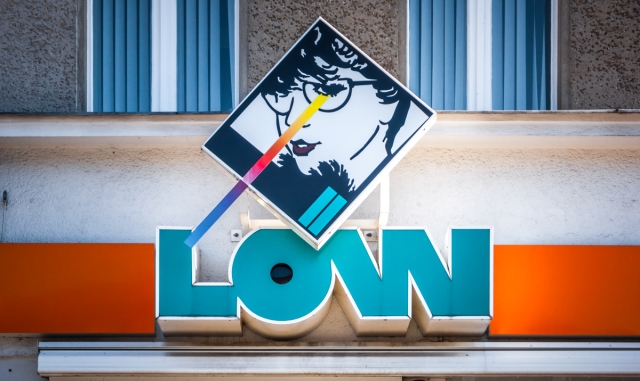
Remember the 80s, when everything looked like this?

The lesser-spotted double reverse diagonal umlaut.
Even more than the Ü, the oval shape and double dots of the O-umlaut can be reworked to suggest a human face. In many instances the dots appear to be laughing with us, but sometimes they merely stare back at us with a blank expression.
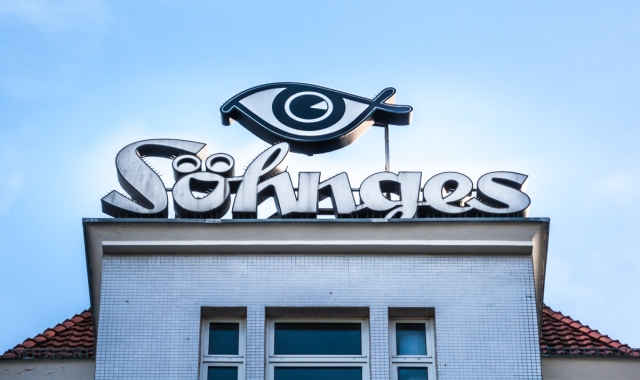
Look how happy that Ö looks, completely oblivious to the fact that it is being watched by the evil eye.

Smile, you’re in Schöneweide.

The hypnotic stare.
And whenever cursive writing is involved, there are chances for the lightning stroke umlaut to make an appearance.

The undisputed king of Umlauts.

The lightning stroke umlaut is one of the great pleasures of cursive neon.
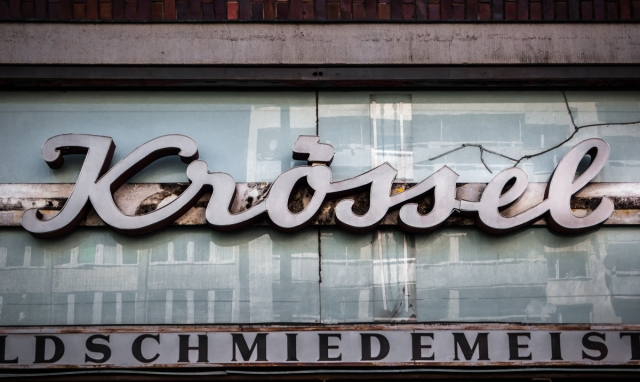
An oddly stylised umlaut for an oddly stylised hand.
All of Western Europe shares a common alphabet, but each European language has adapted that alphabet to its own particular needs. The accented vowels that appear in French and Spanish may look similar, but they serve a very different purpose and are employed in a very different way. English uses almost no diacritics, except for in borrowed words (café, façade) while the Scandinavian languages use several diacritics (Ø, Å) that are found nowhere else. And when we move further east, the Slavic languages that have chosen the Latin alphabet have employed a vast arsenal of markers to cover all the necessary sounds.
The diaeresis is not unique to German: it also appears in French – although intriguingly it is used over the two letters (I and E) where it does not appear in German – and in Finnish, and in both of those languages it serves a very different purpose. Yet the umlaut, as a linguistic phenomenon, belongs very much to the German language. We hope that this series of posts on the Umlauts of Berlin has highlighted the beauty and diversity that can arise from a very specific orthographic challenge, but that is has also illustrated how a language can celebrate its unique identity within a common superstructure.

The Ö in blackletter.
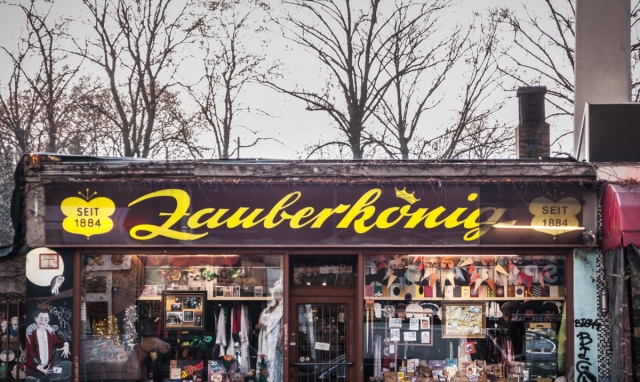
In the word ‘könig’ it is perfectly acceptable to use a crown as the umlaut.
If you don’t already, you should follow us on Twitter at @Berlin_Type, for your daily dose of typographic goodness from Berlin.


Just a note that the superscript “e” hails back to the conventions of early modern German print typography.
LikeLiked by 1 person
“No one goes to Görlitzer Park for the orthography.” Except for you, perhaps. 🙂 As always, thank you for the wonderful examples and your equally wonderful commentary. You make my world bigger and more interesting with every single post.
LikeLiked by 1 person
Thanks for the great blog. It certainly highlighted the beauty of the cute little ‘augen’ to me. Just one minor point. The umlaut, as a linguistic phenomenon, is also found in Turkish as ü and ö (although not as ä), and pronounced the same as in German in both these cases, e.g. ‘döner’ (something that revolves) or Türk.
LikeLiked by 2 people
Once again, I enjoy reading about three of my favourite things: Berlin, signage, typography. Loved the Saugerkönig sign! 🙂
LikeLiked by 1 person
^Oops, I meant Zauberkönig!
LikeLike